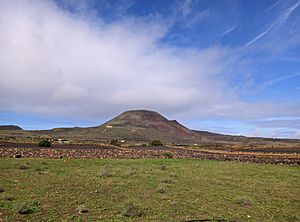Monte Corona facts for kids

The Volcán de La Corona is an ancient volcano on the island of Lanzarote. This island is part of the Canary Islands in Spain. The volcano is near a small village called Yé. It stands tall in the area of Haría.
This volcano is 609 meters (about 2,000 feet) high. It is no longer active, which means it is an extinct volcano. Its last big eruption happened about 4,000 years ago.
Contents
What is Volcán de La Corona?
Volcán de La Corona is a large, cone-shaped mountain. It was formed by many volcanic eruptions over a long time. Today, it looks peaceful and green. But its past was very fiery!
How the Volcano Shaped Lanzarote
When Volcán de La Corona erupted, it sent out huge amounts of hot lava. This lava flowed across a big part of the island's northeast side. As the lava cooled, it created a unique landscape. This area is now known as the Malpais de la Corona. The name "Malpais" means "bad land" because it's rough and rocky.
The lava flows also created amazing underground tunnels. These tunnels are now famous natural attractions. Two of the most popular are the Cueva de los Verdes and the Jameos del Agua.
The Amazing Lava Tunnels
The lava tunnels formed when the outside of a lava flow cooled and hardened. But the hot lava inside kept flowing. When the inside lava drained away, it left behind empty tubes. These tubes are like giant underground caves.
- Cueva de los Verdes: This tunnel is over six kilometers long. Parts of it are open for visitors to explore. You can walk through ancient lava paths.
- Jameos del Agua: This is another part of the same lava tunnel system. It has collapsed sections called "jameos." These open areas let in light and air. They have become home to unique creatures, like blind albino crabs.
These tunnels show the powerful effects of the volcano. They are a reminder of Lanzarote's fiery past.
Exploring the Area Around the Volcano
The area around Volcán de La Corona is great for exploring. You can see how nature reclaims volcanic land. Many unique plants grow here. They have adapted to the rocky soil.
Hiking trails lead up to the volcano's crater. From the top, you get amazing views of the island. You can see the Atlantic Ocean and the surrounding lava fields. It's a perfect spot to learn about geology.
Why is it Important?
Volcán de La Corona is important for several reasons. It helps scientists understand volcanic activity. It also shows how landscapes change over thousands of years. For visitors, it offers a chance to see unique natural wonders. The lava tunnels are a big part of Lanzarote's tourism. They teach us about the island's natural history.
See also
 In Spanish: Monumento natural de La Corona para niños
In Spanish: Monumento natural de La Corona para niños



